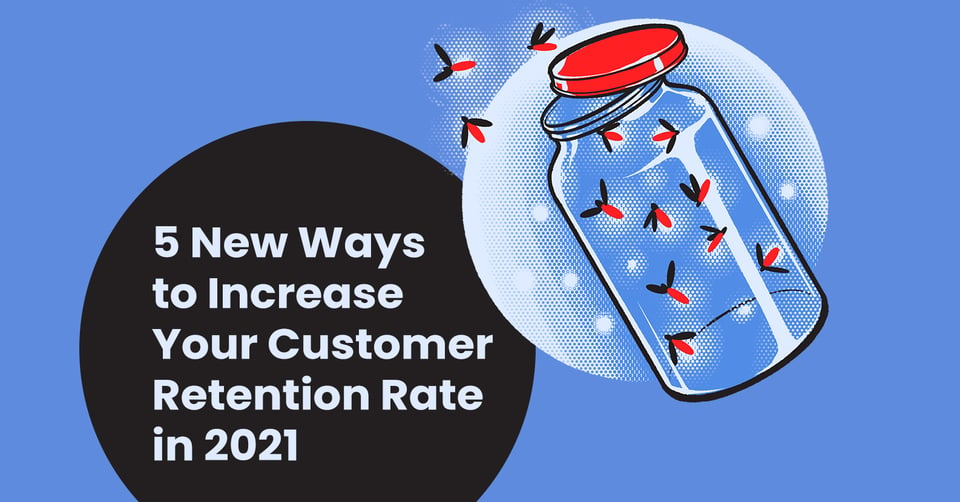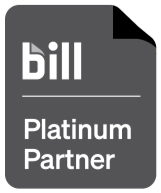
As businesses emerge from the uncertainties of 2020, their priorities — and spending — will shift toward improving customer retention rates. And not just slightly. Forrester analysts predict an overall 30% increase in budget allocation toward loyalty.
Why the sudden emphasis on retention? Because customer attrition is revenue attrition. To calculate exactly how much churn hurts your income, check out the formula created by the experts at Illumin8. If that doesn’t convince you, then consider this: to replace that income, you’ll spend up to 7x more per customer than it costs to keep them loyal in the first place.
The only problem is that in 2021, businesses that rely on traditional customer retention tactics will be left behind. To bring today’s customers with you into the future, use fresh tactics like these.
1. Improve your customer retention rate by analyzing your best customers
Gone are the days of “spray and pray” customer engagement. Tracking your most profitable customers tells you how to re-create those same experiences to attract, convert, and keep even more of them.
It starts by learning where your most vocal supporters and repeat customers came from. What messaging channel, voice, and cadence do they respond to most? What prompts them to engage with your brand? Insights and answers to these questions don’t just open up new ways to engage with new customers — the data also tells you how to best keep current customers coming back.
Once you know what prompted a customer’s first interactions with you, you can move to the next phase of analysis: learning how your most (and least) fruitful customers behave and why. "Our data has shown that getting an early subscriber over the hump from 0 opens → that first open is crucial," writes Jenny Rothenberg, former director of growth at the Morning Brew. "If a user doesn’t open at all in their first few weeks, it’s unlikely they ever will."
"Our data has shown that...
If a user doesn’t open at all in their first few weeks, it’s unlikely they ever will."
As you look for a customer journey analytics tool (software comparison site G2 lists a number of them), try to find one that can identify and segment the highest-profitability customers from the lowest. For your business, this may mean simply the customers who simply bring in the most revenue. Or it might be folks who provide the highest lifetime value. Perhaps it’s the most frequent or cumulative purchases. Some businesses may find their most profitable customers are those with the highest cart value per purchase. Determine what profitability metrics you want to guide your strategy as you work to improve your customer retention rate.
Once you’ve seen the tendencies and behaviors of your most profitable customers, you can confidently stop unprofitable marketing activities. And instead, you guessed it — tailor your offerings to produce more super users and evangelists.
Exciting, right? The concept of strategic data usage is still new: if you discover how to use data to drive business goals (like increasing your customer retention rate), then you’ll be among the mere 15% of overachieving companies that do.
2. Improve your customer retention rate by personalizing experiences
When customers feel like you know them a bit more intimately, they have more reasons to think twice about switching to a competitor. And personalization has finally matured to the point of usefulness.
The new data analytics tools and processes you just established (in #1, above) let you individualize your customer interactions. Personalizing allows you to graduate from a transactional to an emotional relationship. And that’s key to improving your customer retention rate. Forrester Research recently revealed that feelings impact purchasing choices and brand loyalty 1.5x more than other factors.
“A brand that is 'for people like me' likely triggers the emotions that create long term salience and feeds enduring preference,” explains Forrester Vice President and Principal Analyst Dipanjan Chatterjee.
Source: Forrester's New Brand Energy Framework
Personalizing interactions early on in the customer journey can be as simple as showing a blazer for trousers a shopper previously purchased. Or you could greet them by name when they visit your site again.
Source: Ignite Spot homepage
The personalization experts at Smart Insights have put together an updated list of 30 website personalization tools for you to explore.
But personalizing experiences to improve your customer retention rate goes beyond website visits and greetings. Use it to prevent customers from drifting away over time.
Personalized says we haven’t forgotten about you. Recall the Morning Brew’s customer journey analysis. While the data helps them predict future behavior, it also presents a chance to prevent churn.
Rothenberg’s team uses two indicators to trigger churn-prevention messaging:
- • when a reader hasn’t clicked or opened an email in their first 18 days of being a subscriber
- • when a reader hasn’t engaged at all in the last 90 days, no matter when they subscribed
“When either of these criteria is met, we send them an automated email asking if they’re still interested in receiving the Brew,” explains Rothenberg. “Here, we remind them what the Brew is all about and give them access to recent content.”
In your case, this could be customers who haven’t been in your store, or on your website, or used your product.
One word of warning: you can get personalization wrong in a few ways, hurting your relationship and, thus, your recurring revenue.
To play it safe, simply understand the common risks and biggest fails. Then, adopt technology and processes that safeguard against those pitfalls. For example, automatically plug your messaging into search engines to scan recent headlines, so you don’t accidentally make light of recent tragedies. Invest in a customer data platform (CDP) like Lytics to ensure you’re collecting customers’ first party data (without dying cookies) within compliance and creating custom experiences that increase customer lifetime value. And scan business headlines regularly (or set up a Google alert) to stay aware of new blunders to avoid.
3. Improve your customer retention rate with a recurring pricing model
Advertising costs have skyrocketed. On Facebook alone, the cost per 1,000 impressions has nearly doubled in the last year from $8.53 to $11.62. As customer acquisition costs skyrocket through 2021, the smartest business leaders are working to keep their current customer base. One of the best ways to do that is to graduate from only offering one-and-done sales and, instead, shift to a recurring revenue business model.
This means that for service providers, you offer customers ongoing, retainer-based work. And for producers/retailers, you move to a subscription-based ongoing fulfillment relationship.
These days, consumers are getting used to subscribing to everything, from pet food, personal care products, and toys to clothing, gadgets, and cars (that’s right! Porche, Nissan, and Audi are a few examples).
While not new, this recurring revenue is exploding in popularity. From 2012 to 2018, subscription-based businesses enjoyed 5x more revenue growth than S&P 500 companies.
Source: Zuora’s Subscription Economy Index
Why? Because again, customer acquisition costs keep climbing. And one of the most effective ways to plug the “leaky bucket” — a syndrome all businesses must handle — is to set up recurring transactions.
For more on the topic, product-based business leaders can look at PriceIntelligently’s guide to subscriptions. Service-based business leaders should use marketing agencies as inspiration and check out our own must-read guide to pricing services.
4. Improve your customer retention rate by implementing a loyalty program
In 2020, loyalty programs proved to be an effective pandemic-proofing tactic.
The whole year shook up brand devotion. McKinsey analysts found that 75%-83% of U.S. consumers changed their shopping behaviors because of the pandemic.
Meanwhile, though, HubSpot revealed that 78% of consumers said a loyalty program helped convince them to stick with their current retailers/service providers. To improve your customer retention rate, especially in uncertain times, implement a good loyalty program.
Think about loyalty programs as a moat around the one thing most important to your business. It’s not a project to take lightly. In the past, business owners used archaic punch cards that put the responsibility on the customer (to keep them and remember to use them). The buy-10-get-one-free punch card was also easily replicated or faked. These days, businesses can establish effective loyalty programs with sleek automation tools built specifically for their industry.
To choose one, first get inspired. Shopify has a great list of 10 effective, real-world, creative loyalty programs to open your mind. As you read about each, jot down what features of each would appeal to your customers.
Then, compare your list against those on G2’s massive list of loyalty program platforms and tools.
Pro tip: Choose one that provides even more customer behavior data to continue delivering even more loyalty-producing experiences.
When business leaders think of “growth,” they envision customer acquisitions. But every business leader who survived school sports remembers the dedicated coach’s words: the best offense is a good defense.
A loyalty program increases customer satisfaction (CSAT). Today’s businesses with high customer satisfaction rates grow revenue at 2.5 the industry rate. So yes, this type of defense translates to a powerful offense.
Source: McKinsey & Company
5. Improve your customer retention rate by creating a community
Another way to increase loyalty in 2021? Foster a community of your prospects and current customers.
Even if you don’t have a ton of superfans, the fans you have need a place to gather and geek out together.
This way, they can...
- • experience the emotions you want them to feel
- • affirm each other’s love of your product or service
- • share tips and learn how to better use the product or service
- • multiply
The Mayo Clinic implemented a community called Connect with five customer retention goals in mind.
Source: Community Consultants at FeverBee
The program has been massively successful:
Source: FeverBee
But you don’t have to be a mammoth publicly traded company to start, nurture, and profit from a branded community.
Aaptiv, an audio fitness instruction app, is a great example of a small business that uses an in-app community to improve its customer retention rate. Zach Beatty, the brand’s former VP of marketing, says that the whole fitness industry has a loyalty problem, and his team is out to develop casual signups into exercise addicts via the Aaptiv community. To participate, users simply share their post-workout feelings (and, if desired, a sweaty selfie) to the “team” tab of their app. A chorus of fellow exercisers congratulates them with affirmations, applause, and virtual confetti, further boosting their hard-won endorphin high.
Source: Aaptiv
“Both Aaptiv and its members succeed, in part, because they’ve given up their addiction to quick fixes, and recognized that nothing can replace hard work,” write the web analytics experts at Mixpanel. “Aaptiv members know that meal-replacement shakes can support an active lifestyle, but not substitute for one. Similarly, Zach knows that growth marketing tactics can supplement a customer strategy, but they cannot be the strategy—not if he wants customers to stick around.”
Keep the customers you’ve worked hard to acquire
You may have heard the saying, “What got you here won’t get you there.” In light of 2020’s curveballs and 2021’s opportunities, the expression is more true than ever: businesses need new takes on old customer retention tactics to develop loyalty that lasts.
Each idea above costs you precious time, energy, and money to implement. Decide which methods will work best to increase your customer retention rate by calling an Ignite Spot accountant now. We’ll spend 30 minutes with you, free of charge, to help you discover how to fix your leaky bucket and get more mileage out of your customer acquisition dollars.












.png)




